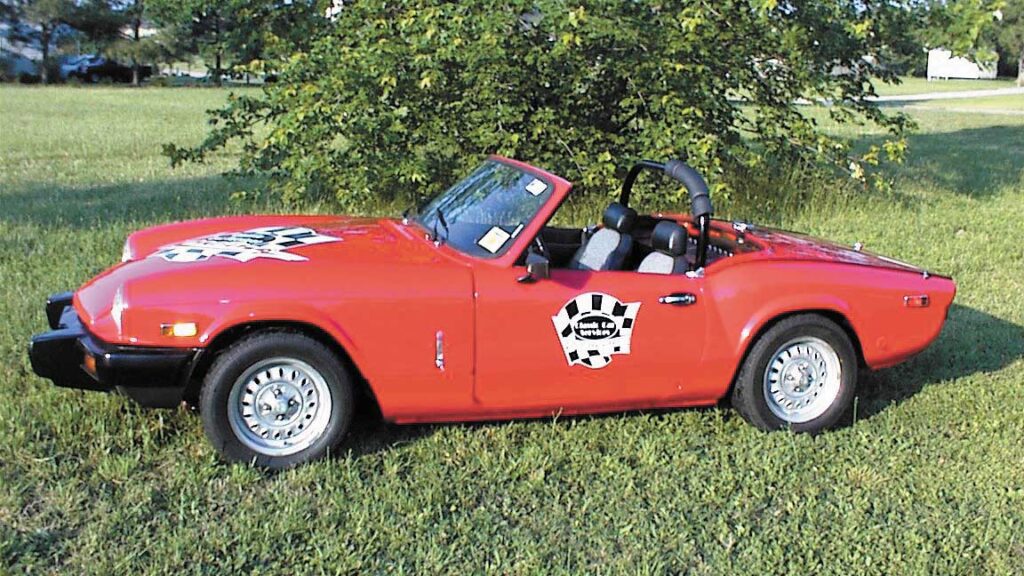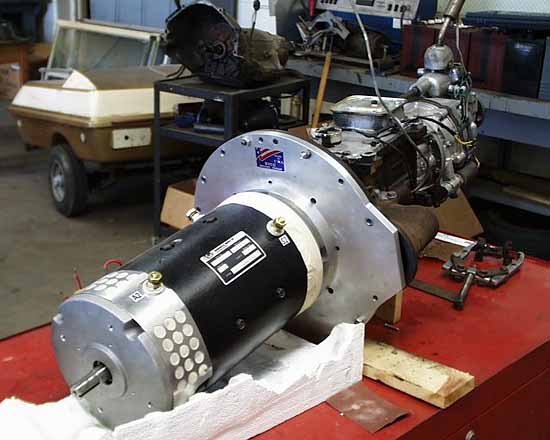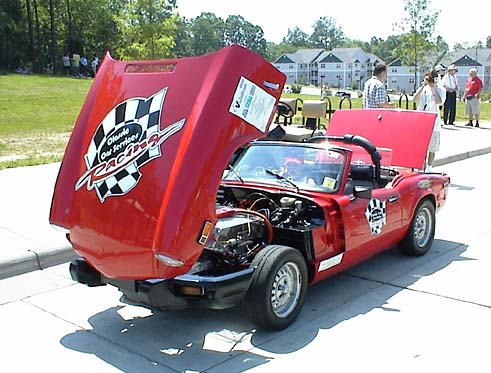Ralph Goodwin’s DC 203-06-4001A (Electric)

What do you get when you take a smog choked British sports car, put it on a diet and quadruple the horsepower! You get the “Fastest Gun In The East!” A electric car that is fun to drive, has unbelievable performance, and is cheap to operate and maintain! A car that can autocross with the best, and serve as a poster car for cleaner air!
Built by North Johnston High School students in Kenly, NC this car was designed for participation in the Carolina Electric Vehicle Challenge. This car proves that electric cars don’t have to be slow, difficult to drive or ougly! Competing against high schools from across the southeast US, the Spitfire was recognized at the competition as being the best designed and constructed vehicle there, and on the autocross track clearly dominated the competition!
The car is owned by Pat and Ralph Goodwin. Their antique car insurance agency, Classic Car Services Inc. sponsored the car in the competition so afterwards they would have a unique car that they could use to promote their business at shows and autocross events across North Carolina.
This story documents the work that the students did on the car. You can also find technical design information about the car and the components that went into the conversion.
Where every project starts…Thinking about it!
One might say this was the view that got me in trouble! I work for a electric utility and manage our electric vehicle program. As part of my responsibility I work with high school students who learn about electric vehicles, even building their own conversion. Many times as I lifted the hood on this Spitfire, I thought about how easy it would be to convert to electric power. Lots of places to place batteries. Particularly the smaller high performance absorbed glass mat batteries, such as Genesis Hawkers. The fact that someone had long ago removed much of the required smog equipment made this car a interesting candidate for conversion!
Removal of the radiator clearly showed room for batteries. Common sense cautioned about placing too much lead ahead of the front axle, but that’s something the students will have to figure out!
Other places to put batteries include the previous gas tank location. The gas tank location is on the shelf visible between the two wheel wells. Batteries can go in front of, on and behind this shelf. Again, one of the tasks the students will have is to optimize battery location to achieve the best weight distribution.
Taking it apart!
To start we weighed the car. Then we pulled the engine, and body tub. All this was to enable us to get to the frame. All the suspension components are removed, examined and replacements ordered as needed.
The front cross member is being modified to allow room for the ADC electric motor. This modification will allow the motor to be mounted low in the frame, thus helping to keep a low center of gravity. A little more sanding and the students will have the frame ready. The modifications tomove the cross member forward to allow proper mounting of the motor is complete. This modification will make sure that the proper driveline alignment is maintained.Front suspension components have been cleaned, repaired and primed, ready for painting, new bushings, etc and reassembly.

Here it is! The motor attached to the overdrive transmission. As you can see we have used a special adapter plate. What you can’t see is that this adapter lets us use the original type clutch!
No, we aren’t going to use ordinary batteries! Here is one of the Hawkers that will provide the energy to propel our project!
How can you not get excited at this point! Kevin Boykin, lead instructor on the project checks everything out. Mr. Boykin is recognized as being one of the best in the southeast US at converting a gas car to electric power!
Getting close!
Here you can see the motor mounted in the frame and the front battery box in front of it. The front battery box has four of the Genesis batteries in it. The four batteries weigh about 135 lbs. The students were able to put the battery box between the frame rails without interfering with the front sway bar mounts or the steering rack. Click here to see the bottom of the front battery box.
Check out the Carrera shocks supplied by TSI Automotive! These shocks, the Yokohama autocross tires, and the camber compensator on the rear should help to keep all 4 tires firmly planted on the autocross course!
The four batteries up front aren’t nearly enough, so there are 9 more that will sit behind the seat! This battery box will be power vented outside of the car. 165 pounds over the axle and about 135 in front of it! The students wanted to keep weight distribution as close to stock as possible, so no batteries in the trunk! The thirteen total are fine for autocrossing but would not last for extended driving. More batteries were needed. We decided to add DEKA 8G22NF batteries and mount them in a small trailer. The trailer is designed to be pulled behind a motorcycle. A nice light-weight, removable solution.
Main Electrical Components
Motor: Advanced DC 203-06-4001A
The brushed series DC motor is the best overall motor for affordable road-going conversions available today. AC motors operate at high rpm that have to be stepped down, and have expensive and complex speed control systems. Brushless DC motors also require expensive controllers. Permanent magnet motors are very efficient, but only in a very narrow rpm band, and quickly lose their efficiency in the varying speeds of normal driving. Shunt and compound motors are more expensive to build and have poorer acceleration than series motors. For these reasons, the brushed series DC motor is the motor of choice.
Motor Ratings
It is not accurate to refer to a “10 hp motor” or a “15 hp motor”, because horsepower will vary with volts and amps, and peak horsepower will be much higher than the continuous rating. It is also confusing to compare electric motors to gas engines, since electric motors are given a continuous rating under load, and gas engines are rated at their peak horsepower unloaded.
The motor weighs 107 lbs. and was mounted to the Spitfire Overdrive Transmission. The students originally tried to use the original type clutch but found that it couldn’t begin to handle the increased torque and horsepower. After locking the clutch plate to the pressure plate assembly, the students found the car had ample power to pull from a standing start in any gear, reducing the need to change gears! When autocrossing the car it is usually run in second or third gear.
Controller: DCP Raptor 1200
The motor controller used employs a microprocessor based control system (blue box in figure 5). It provides high average currents at low throttle positions, delivering exceptional acceleration! Input from the battery pack is 156 VDC, with peak output at 1200 amps.
Batteries: Hawker Genesis 42Ah
There are 13 of the Genesis 42Ah batteries for a total of 152 volts. These batteries are distributed through the car to maintain proper weight distribution.
Model G42 Length 7.775″
Width 6.525″ Height 6.715″
Weight 32.9 lbs Total Weight 427.7 lbs
Preparing The Car For Autocross Competition
Part of the Carolina EV Challenge includes a autocross competition. Needless to say, significant bragging rights go to the quickest car between the cones!

The Triumph Spitfire has a past that was hard to beat! In SCCA competition is finished top in its classes for many of the years the car was in production. But how would it do configured as a electric vehicle? How well would it compete with newer conversions?
Of course key to success was rebuilding everything with modern day components. This included poly bushings all around and a complete rebuild of the braking system. Carrera competition shocks were added all around and Carrera springs were added up front. To help control the rear end a Curry Camber Compensator was installed. Finally a set of Yokohama autocross tires were added!
Handling is unbelievable! The car runs like its on a wire!
